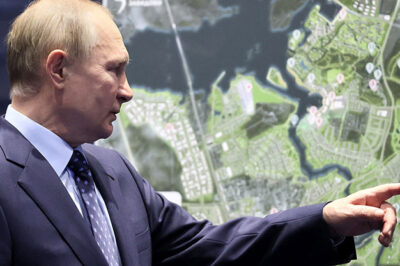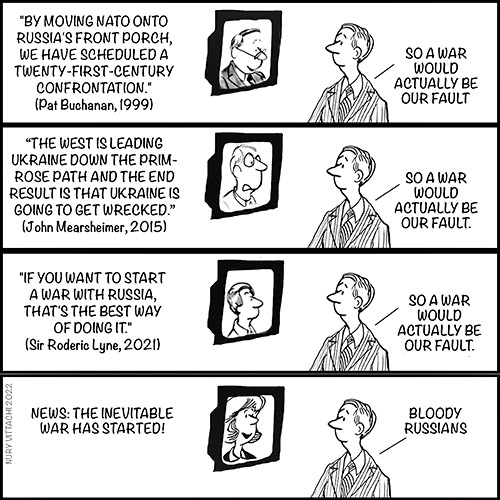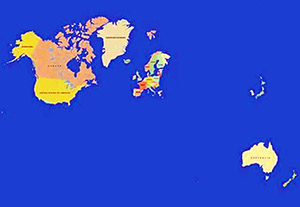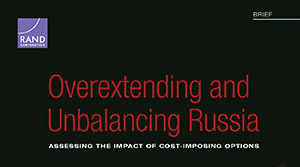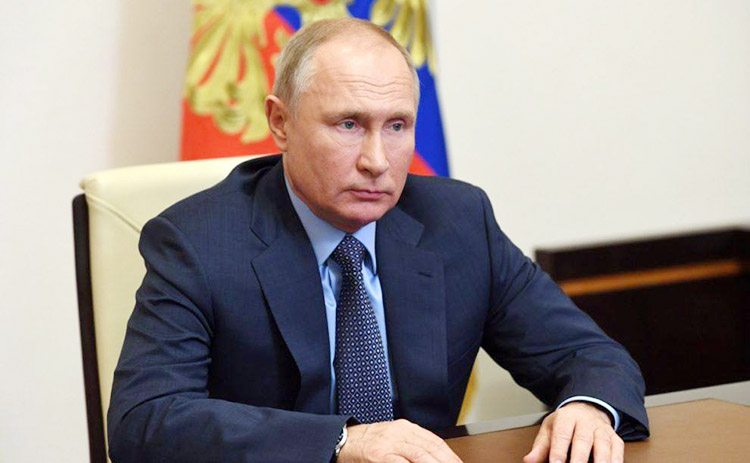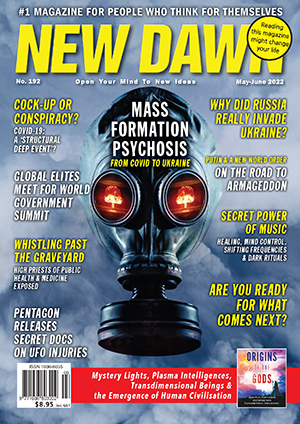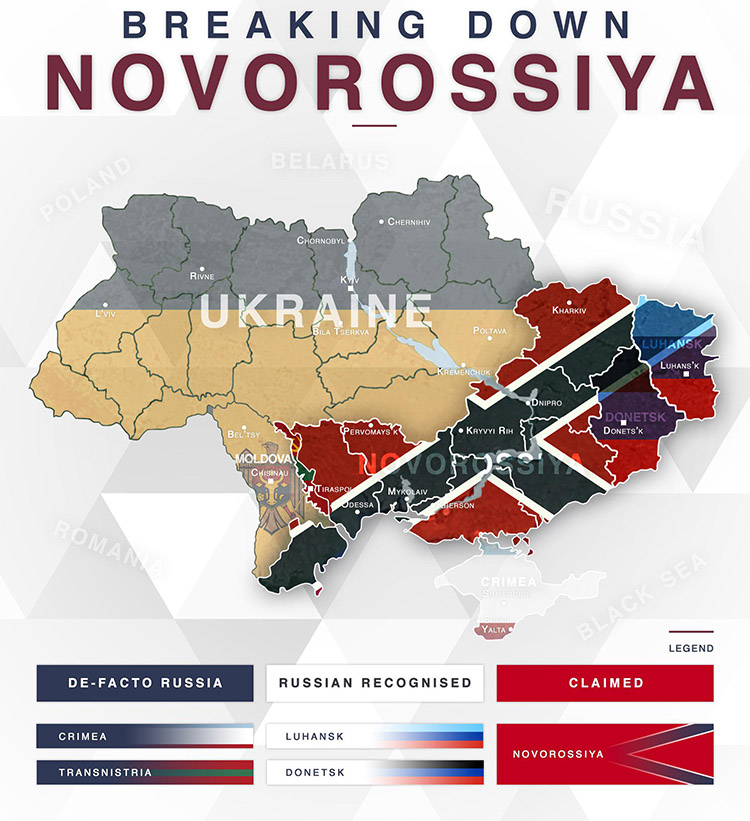From New Dawn 192 (May-June 2022)
The following article by Patrick Henningsen – written only months after Russia launched its special military operation in Ukraine on 24 February 2022 – explains the background dynamics of this war. The facts outlined here – that were suppressed in the West but well known to informed observers – are only now emerging in mainstream media as Western backers of Ukraine begin to face reality.
There is no avoiding war; it can only be postponed to the advantage of others.
– Niccolo Machiavelli
They say timing is everything. Had this war happened two years earlier, or one year later, the outcome would have been vastly different.
As for the great Atlanticist power bloc, this isn’t a war they’ve been willing to fight, not in the traditional military sense anyway.
As the mortars and bombs continue to fall and efforts to kickstart negotiations are ongoing, a sustainable path to peace seems unlikely to emerge in Ukraine.
While Russia seems intent on seeing through its “Special Military Operation,” the US and its allies will have to decide what they want and exactly how long they plan to fight Russia down to the last Ukrainian.
The western chorus of nations contends that by waging their ‘war of choice’ against its neighbour Ukraine, the Russian Federation and its President Vladimir Putin have fallen foul of the vaunted Rules-Based International Order. By doing so, they have effectively left the international community.
However, on closer examination of the evidence and historical context surrounding this highly contentious geopolitical event, it becomes clear that it was the “international community” which left Russia – leaving it with no choice but to pursue its national security interests on its own accord.
As it stands, Russia, Ukraine, and the North Atlantic Treaty Organisation (NATO) alliance are now at war, with each party firmly in the belief that they are fighting an existential conflict – not over any particular political or territorial dispute but for their future existence, or in the case of NATO, its relevance as a regional hegemonic entity.
No one saw this coming, or did they?
How Did We Get Here?
It’s no secret that over past decades numerous foreign policy experts warned that NATO’s continued eastward expansion, coupled with the US and UK’s increasingly strident rhetoric and aggressive policies directed against Russia would end up fomenting war in Ukraine.
Chief among those were luminaries like George Kennan and Henry Kissinger. Kennan, the architect of America’s policy of Soviet containment during the Cold War, was adamant that unchecked NATO expansion would eventually lead to war with Russia. Kissinger agreed, and thought that Ukraine should not be dominated by either NATO or Russia but rather act as a neutral bridge between east and west.
Also raising the alarm was one of America’s leading international relations scholars, Professor John Mearsheimer, who succinctly drove this same point home in public interviews and lectures,1 but even his cogent and considered realist arguments garnered little interest within Washington’s foreign policy clique.
The US, UK, and western Europe were fully engaged on this path following the February 2014 Maidan coup d’etat in Ukraine, especially after Russia’s supposed ‘annexation’ (as the West refer to it, while Russians will regard it as a reunification) of Crimea, an act that triggered some of the harshest economic sanctions seen yet prosecuted by the US and European Union against Russia.
And just like that, The Great Game was truly in play again.
Undoubtedly, one of the material consequences of the 2014 US-backed coup in Kyiv was Ukraine losing the Crimean Peninsula to the Russian Federation in February/March of that year. Two main factors made this transfer a fait accompli. Firstly, with a predominantly Russian population, Crimeans viewed the unconstitutional toppling of democratically elected President Viktor Yanukovych in Kyiv as an illegitimate seizure of the government and feared ethnically-motivated retribution against Russians and Russian-speaking citizens at the hands of western-backed radical Ukrainian nationalists who had seized power.
This policy of disenfranchisement and lustration (where a new regime bars any opponents to its legitimacy from participating in the political process) had already reared its ugly head in other primarily Russian-speaking regions of Ukraine, in the eastern region of Donbass, where protests against Kyiv’s illegal coup regime broke out in Donetsk and Luhansk. They were suddenly treated as insurrectionists for not recognising the new putsch government in Kyiv, which effectively suspended the parliamentary representation of the Donbass parties, and even deployed the military to quell the growing political opposition.
Knowing they may meet a similar fate, Crimea’s local councils held a regional referendum on leaving Ukraine and joining the Russian Federation. The result was overwhelming, with roughly 95% favouring secession. The process was made that much easier by the fact that Crimea is home to one of Russia’s largest military installations housing some 20,000 personnel located on the southern-most tip of Crimea, in the port city of Sevastopol. Since the time of Catherine the Great it has been the historic home of Russia’s Black Sea Fleet, and since the fall of the Soviet Union, Russia had been leasing the base from the Ukrainian state.
It should be noted that none of this would have gone smoothly had the overwhelming majority of Crimea not supported the new mandate. That, and the fact that Crimea had previously belonged to Russia up until 1954 when then Soviet premier Nikita Khrushchev gave the peninsula to the Soviet republic of Ukraine – a purely political move designed to curry favour with Ukraine at the time – explains why this changing of the guard was virtually seamless.
This brings us to the second reason Crimea reunited with Russia. From a national security standpoint, Moscow could not risk the fate of its main naval port to the machinations of an unstable, US-backed radical nationalist junta in Kyiv. From Russia’s point of view, if Ukraine joined the EU, or worse, was folded into the NATO alliance, it would only be a matter of time before Moscow’s cherished warm water port was jeopardised, and with that closing Russia’s access to the Mediterranean Sea.
If Ukraine joined NATO and then tried to take back Crimea by force, Russia would be compelled to retaliate, triggering NATO Article 5, opening the door for all-out war between NATO and Russia. For Russia, that risk was simply unacceptable. From a statecraft point of view, these series of events can be viewed as totally logical, and not the impulsive machinations of an unstable despot in Moscow.
Russia’s canny but ultimately necessary geopolitical move incensed the West to no end. From this point on, Washington and London have ben determined to find new ways to isolate Russia, beginning with the work of discrediting and isolating them internationally, and aiming to somehow retake the Donbass and Crimea, while edging ever closer to achieving regime change in Moscow. That’s the general plan, and war planners in Washington and Brussels are sticking to it.
A War Like No Other
For all practical purposes, World War III has already begun. It is a war being fought on multiple levels, and the conflagration over Ukraine may only be the start.
For its part, the West has declared full-blown economic war against Russia including a total embargo on trade and commerce, and the banning and restriction of Russian communications, media, culture, and even participation in international sports. Who would have imagined that a leading global power could be cancelled, at least in western spheres of influence in the “International Community” as it common refers to itself, the moralising confederation comprised mainly of North America, UK, the European Union, Japan, Australia and New Zealand. The rest of the world, including China, India, Africa, the Middle East, and large portions of South America including Brazil, have taken a much more neutral stance in relation to Russia.
But in order to really understand what is happening, we must consider how we arrived at this point in history, and maybe speculate where events are likely to take us once the dust finally settles on this phase of the conflict.
How We Got Here
The narrative in popular western mainstream media discourse is that this war came out of nowhere – an impulsive act of hubris by an unstable ‘mad man’ and dictator, Russian President Vladimir Putin, who simply decided one day to invade Ukraine to realise his ambition of reconstituting the former Soviet empire. That’s a favourite fallback position for most American and British politicians and pundits. If only it were true.
In reality, we are seeing the logical conclusion of a series of events and provocations coming from NATO and Ukraine itself. Ever since their open invitation to Ukraine and Georgia at the 2008 NATO Summit in Bucharest, the West has steadily supplied weapons, military ‘advisors’, and other technical and intelligence support to those former Soviet republics. Could Russia afford to wait for US-made medium-range missiles to arrive in those countries?
For those and other reasons, Russia’s military intervention did not surprise foreign policy heavyweights like Kissinger or Mearsheimer. Even Ukrainian president Vodolymyr Zelenskyy’s political advisor, Oleksiy Arestovich, predicted this clash would unfold during a 2019 interview.2
If that’s not convincing enough, read the RAND Corporation’s 2019 strategic report, “Overextending and Unbalancing Russia,”3 which describes chapter and verse how Washington’s primary goal has been to undermine Russia by repeating what it considers as past successes against the Soviet Union during the Cold War. Only this time, rather than ‘hedge for peace’ by simultaneously engaging in productive bilateral relations or outpacing the enemy in arms and technology, the report opines that NATO should focus on enacting a dizzying range of anti-Russia measures in what it calls hybrid war. This includes leveraging NATO members against Russia, engaging in political and economic warfare, and active measures across all information warfare fronts. Whereas communism vs capitalism was the defining dialectic that shaped strategy and tactics during the old Cold War, new quasi-ideological fault lines should be reframed, like ‘dictatorship vs democracy,’ and the fomenting of divisions on religious and ethno-nationalist lines. Beyond this, we have the military theatres. For war planners at RAND, these are ranked according to perceived risks, benefits, and “likelihood of success.”
The RAND report also suggests capitalising on what the West perceives as Russia’s “deep-seated” anxieties about provocations from the West and advises that this vulnerability must be exploited to get Russia to react. And react it did.
When Russia launched its military intervention in Ukraine on 24 February 2022, it was the culmination of a long series of events that had effectively forced Russia into a national security quandary that would be difficult to avoid without making serious compromises. It could ultimately degrade its current position as a global power in the short term but, more importantly, pose a severe risk to its territorial integrity in the long term.
Operation Z: Putin Springs the Trap?
To present a thorough analysis of this historic impasse taking place over Ukraine, we need to first cast the scene back a few centuries, followed by a detailed depiction of both World Wars, and give a brief analysis of the formation and dissolution of the Soviet Union, including a granular look at the post-Soviet development of its respective satellite states. In New Dawn 191 (Mar-Apr), I covered some of the historical rivalries between the British and Russian empires in my article, ‘The Great Game 2.0: What’s Behind the Ukraine Crisis’.
For this analysis, we’ll move the timeline forward to February 2014, to the infamous Maidan uprising, known locally as the “Revolution of Dignity” in Kyiv. While the mainstream media likes to portray this colour revolution as a grassroots uprising ‘embodying the spirit of western democracy’ with young Ukrainians expressing their EU aspirations, the hard reality was that this was a violent coup d’etat, leading to the ouster of a democratically elected president, Viktor Yanukovych. The evidence now reveals that he was replaced by a succession of hand-picked US political puppets installed to do the bidding of regime change practitioners in Washington.
This was exposed in detail during a leaked phone call between then US Undersecretary of State, Victoria Nuland, and US Ambassador Geoffrey R. Pyatt in Kyiv. The degree to which they were micromanaging their new incoming regime was astonishing. The full sequence of events is well-documented in director Igor Lopatonok’s 2016 film, Ukraine on Fire, featuring Oliver Stone.
It turns out that this hostile takeover of Ukrainian politics was in the works for a very long time. Perhaps the most shocking aspect of the 2014 Maidan coup was how the US and its allies harnessed the power of Ukraine’s radical far-right nationalist cells to enforce a political line on the streets of towns and cities across the country.
Many refer to movements like Right Sector (Pravyy Sektor) and their respective paramilitary and ‘volunteer corps’ militant factions as Neo Nazi. However, they are much more than that. By any reasonable measure, these are not ‘neo’, but rather, bona fide Nazis – adherents to the Nazi ideology, descendants in the political (and in some cases, genealogical) lineage of Hitler’s western Ukrainian brigades, and inspired by controversial figures like Stepan Bandera, who to this day, is still idolised by radical nationalists in Ukraine. Bandera was leader of the Organisation of Ukrainian Nationalists in the 1930s and 1940s, which fought alongside the Waffen SS during Nazi Germany’s scorched earth march towards Stalingrad. It is a matter of historical record that Banderites engaged in pogroms and atrocities against Jews, as part of the broader Holocaust, as well as slaughtering Poles. History also reveals that Washington and the CIA groomed Banderite cells in western Ukraine after WWII through programs like Operation Aerodynamic.4
Following the Maidan coup, Washington installed interim Prime Minister Arseniy Yatsenyuk, followed by billionaire oligarch, President Petro Poroshenko, who marshalled these same radical nationalist forces and began integrating them into the Ukrainian military structure. Extremist militias like the Aidar and Azov Battalions were deputised to help Kyiv prosecute a brutal civil war in eastern Ukraine’s Donbass region – to put down the rebellion against the post-coup government which the rebel opposition in Donetsk and Luhansk regarded as an unconstitutional regime.
After his election, Poroshenko mounted an “anti-terror operation” in the eastern regions – bringing the full force of Ukraine’s military against its own people. A bloody eight-year-long civil war ensued that was systematically whitewashed from Western mainstream media and politics. Burying this inconvenient truth was essential for the United States, British and their NATO partners to condition the western public to see no evil in a newly-minted ‘democratic’ Ukraine.
Meanwhile, Russia was incensed, only it could not intervene militarily in Ukraine to protect ethnic Russians without provoking a major international incident. So instead, it provided diplomatic, economic aid, no doubt some special military support and technical training, likely comprising of some arms, hardware, intelligence and communications support. For its part, Moscow also offered invaluable international media coverage of the conflict through Russian outlets like RT and Sputnik.
In order to de-escalate the situation, Russia, Ukraine, Belarus, France and Germany drafted the Minsk Accords, or “Minsk I & II,” in 2014 and 2015 respectively. This initially helped reduce fighting which had already taken thousands of lives and displaced many hundreds of thousands from the region. It’s important to note here that Minsk Process was codified by UN Security Council Resolution 2202, unanimously endorsing the “Package of measures for the Implementation of the Minsk Agreements.” But unfortunately, in the years that followed, successive US-backed governments in Kyiv systematically undermined the agreement and rather than de-escalate the fighting in Donbass, increased the military build-up, culminating in a massive uptick in troop and equipment deployments to the region under President Zelenskyy.
Ironically (or not), Zelenskyy ran for office in 2019 on the promise of uniting the country and ‘bringing peace’ to Donbass, neither of which happened. Instead, the violence and proliferation of far-right militias in Donbass increased dramatically. It was clear this is what Ukrainians wanted, which was a far cry from what eventually unfolded. To make matters worse, Zelenskyy threw gasoline on the fire by constantly courting NATO membership when he (and his western handlers) knew full well that this was an absolute red line for Russia. Zelenskyy could have defused tensions earlier by disavowing NATO aspirations and declaring Ukraine a neutral state. The coup de grace came in February 2022 after Zelenskyy remarked at the Munich Security Conference that he would like his country to acquire nuclear weapons. At that point few can argue that Russia lacked sufficient reason to make its bold move in order to secure its own vital national security interests.
It is not at all surprising that most western pundits are largely aloof to this progression of events, and that Russia’s concerted moves are as much political as they are military. The great strategist Carl von Clausewitz said it best in his seminal text, One War: “War is simply the continuation of political intercourse with the addition of other means.”
In the spring of 2021, Moscow would increase its frequency of military drills and manoeuvrers, amassing more military forces along its border with Ukraine. In December of that year, Washington and its allies began raising the alarm that Russia was planning to invade Ukraine. Moscow issued an urgent letter to the Washington demanding that its security concerned be addressed immediately to avoid further escalation, but its overtures were largely brushed aside and ignored by the US State Department. For the next three months, western alarm bells dominated media coverage, all the while Russia was denying any intention to move its forces into Ukraine.
Then on 21 February something extraordinary happened. Vladimir Putin sprung the trap.
After eight long years of bloodshed and failed peace negotiations, the Russian president took to the airwaves to announce Moscow’s formal recognition of the independent republics of Donetsk and Luhansk. For a legal perspective, this immediately qualified them for official Russian military protection, including the establishment of humanitarian corridors which were quickly opened. After more than seven years of stalled diplomacy, Moscow finally chose to abandon the already dead Minsk agreement and directly deal with the situation in Donbass – and the threat posed by a US-controlled and NATO-occupied Ukraine to its national homeland security.
On 24 February, Putin took to the airwaves again to deliver an hour-long lecture on the geographical, cultural, political, and geopolitical history of Ukraine and its interconnected relationship to Russia. Western pundits were left puzzled. Why was Putin delivering this masterclass in Soviet history and articulating concepts underpinning Russia’s national security doctrine?
Those questions were soon answered when Moscow announced its military intervention code-named “Z,” effectively invading Ukraine from four different directions, with these goals: to secure the Donbass, followed by “demilitarisation,” and “denazification” of Ukraine.
Within 72 hours, the Russian armed forces had begun their “Special Military Operation” (SMO).
For the West, decrying Russia’s surprise invasion of Ukraine means they’ve suddenly discovered the concept of international law and are pointing to Article 51 of the United Nations Charter, and how the international community must condemn this egregious violation of Ukraine’s territorial integrity. While this may be true with respect to the letter of the law in this instance, such international treaties have never hindered the United States and its allies in the recent past – not in Iraq, Libya, Yemen, Syria, Yugoslavia, nor in Vietnam, to name but a few. The same could be said for Turkey’s incursions and occupations in Cyprus and northern Syria, and especially Israel’s 75 year-long incursion, illegal occupation and systematic ethnic cleansing of the native Palestinian population.
Following Russia’s SMO, the West enacted an unprecedented reflexive, collective response – a program of full-spectrum dominance – which includes overlapping strategies of hybrid warfare, the results of which have invariably altered the current world order.
Hybrid Warfare & Full-Spectrum Dominance
Governments and military structures are engaged in hybrid warfare. If you’re living in the West, they don’t tell you that you are immersed in a theatre of constant conflict is a 360-degree hippodrome of mass media information warfare with active measures and countermeasures. Even seemingly innocent bystanders – the general public – are viewed by governments and military strategists as active participants in the broader war theatre.
This has always been the case throughout history, articulated as propaganda and soft power, with citizens in whatever country on whatever side find themselves in a war for the age-old ‘battle for hearts and minds’. The process of public engagement also requires an incendiary ingredient to drive it, whereby the state conditions the people to both fear and hate the enemy de jour. Without that sense of personal and collective threat, or at the very least, in the Orwellian sense, that “two minutes of hate,” members of the public will not feel civically and emotionally invested in the process.
Additionally, an emerging new compliment to the military theatre is cyber warfare, now touted by western planners as a key domain to build up offensive and defensive capabilities. Klaus Schwab in Davos is gaming out this digital conflagration with the World Economic Forum’s “Cyber Polygon” tabletop simulations.
As much as the mainstream media spinners try to frame it, this Russia vs ‘The West’ conflict is not the proverbial ‘black hat vs white hat’ square-off. On the contrary, it is incredibly complex with many overlapping layers of history, culture, ethnic strife, and political and geopolitical forces which push and pull various actors, both in the theatre of war and on its periphery.
It’s crucial to understand that this is a proxy war pitting a US-UK-led NATO against Russia using Ukraine as the proxy, or cudgel, to poke the Russian bear. This was done numerous times during the Cold War, and it should be of no surprise history again repeats itself here. As it cannot engage in a direct military fashion, NATO is applying the Syrian model – trafficking an unlimited number of lethal arms, supplies and military advisors into Ukraine, with the express goal stated in the RAND document of wearing down and’ overextending’ Russia. Western planners openly boast about creating “another Afghanistan” for Russia.
Economic Warfare
Part of this hybrid warfare was the “mother of all sanctions,” an all-out economic war waged by the West against Russia to destroy their economy, hoping it provokes the Russian population to rise up and overthrow their leader. This is an attempt to cancel what is arguably the world’s top commodities producer – exporting a large share of the world’s gas, oil, wheat, fertiliser, minerals and key components for the highly globalised nuclear power, and space exploration industries.
The move to ban and restrict the Western bloc from purchasing Russian natural gas, oil, food and fertiliser has come even though Europe overly relies on these Russian supplies to heat their homes and provide power, minerals and product to run their industries, and put food on their tables. This highly self-destructive collective economic suicide pact is already backfiring spectacularly in the West, triggering tumults in already shaky natural gas and oil markets, and causing food shortages, supply chain disruptions, and a lack of available and affordable supplies of grains, sunflower oil, fertiliser and other essential staples.
Some western farmers cannot plant in the spring due to either a lack of supplies or the fact that the fertiliser price is too high, making farming unprofitable. A hike in fuel prices has triggered record-levels of inflation across the board in the West, spelling a lower standard of living for the working and middle classes right across the western world.
In another significant development, in late March the US sanctioned Russia’s Central Bank and seized some $300 billion of Russia’s foreign currency assets to bring on financial armageddon in Russia. President Putin turned the tables by announcing that Russia would no longer accept dollars and euros for its gas and oil, and payment would need to be made in Roubles. With the stroke of a pen, Putin made the Russian Rouble a type of reserve currency, and there was an immediate effect on the US dollar’s near-global monopoly as the pre-eminent world reserve currency. To make this move stick, Putin pegged the Rouble to gold, effectively making the Rouble a gold-backed currency. Russia’s currency was further bolstered by the fact it’s backed by a basket of essential commodities like oil, gas, and wheat. Interestingly, this very same move propelled the US economy after the Second World War following the Bretton Woods Agreement.
Time will tell how well this pans out for the Russian economy, but early signs are western economies are suffering most in sanctions blowback – the sort of damage that might eventually lead to political consequences in elections.
The only people in the West who seem pleased with these ruptures are the green lobby and Klaus Schwab’s Great Reset parishioners, both dreaming to leverage this artificial crisis to advance their ‘sustainable’ agendas and press home the argument that fossil fuels are now too expensive and a liability to global stability (because they supposedly pad the pockets of the Russian war machine).
Will it work or will it all end in tears? You might ask the Central Bankers who have certainly used this crisis to accelerate their roll-out of a new Central Bank Digital Currency (CBDC), completely in line with the Great Reset’s digital global fiat and cashless society, with its digital ID wallets, to be tied to your social and carbon credits. Many believe, and rightfully so, that this looks very much like the final implementation stage of the globalist plan to enslave the planet. It’s becoming harder to argue with that conspiracy theory.
Are we seeing a new bipolar or even multipolar world order taking shape – with Russia and China leading Eurasia in one direction while Klaus and the West head towards their technocratic digital ‘utopia’? If this unfolds, we may see a bifurcated world economy and digital media, on polar ends of a bifurcated world order, with different rules, values, and practices in different hemispheres.
Negotiating into a New World
As we go to press, Ukraine’s actor-cum-statesman, Volodymyr Zelenskyy, was still being paraded (via Zoom) in front of US Congress, the British, Canadian, and Australian parliaments, and the Council of Europe in Brussels, with western leaders enthusiastically chanting the nationalist mantra Slava Ukraini!” (Glory to Ukraine!)
This issue has become a global cause célèbre in the West, with Ukrainian flags flying over municipal buildings, businesses, and lapel pins, and with school children and churches doing bake sales, airline hostesses passing the hat around on long-haul flights, and other endless online fundraisers – all raising money for the Ukrainian cause as everyone joins in the biggest geopolitical virtue-signalling campaign in modern history.
However, none of this will change the facts on the ground.
What we know of the ongoing conflict resolution talks between Russia and Ukraine is that there is a stalling for time which is likely being directed behind the scenes by the US State Department. In reference to the previously-cited RAND report and US/UK/NATO strategy, stretched-out negotiations allow for the unrestricted flow of weapons over the Polish border into western Ukraine. But the longer Kyiv drags this on, the more territory Zelenskyy’s Ukraine stands to lose. The territory presently held by Russian forces is beginning to resemble historic “Novorossiya,” which is also the proposed confederation of the Donetsk and Luhansk People’s Republic. This would create a land bridge stretching from Moldova, over to Crimea, across to Mariupol, and up to Kharkov. The remainder of the current Ukrainian state would have lost access to the Black Sea.
Another potential outcome is providing the West and its media establishment with a face-saving ‘out’ – something like how the invasion has gone so poorly for Russia and wore them down so much that in the end they were forced to negotiate a settlement due to the brave Zelenskyy-led resistance. Remember, the western PR machine can spin anything into a win, no matter how bad things have really gone.
One of the most extraordinary parts of this story is the revelation that just days before the Russian invasion, Zelenskyy was offered a peace deal by German chancellor Olaf Scholz while attending the Munich Security Conference – but the Ukrainian president turned it down.6 The peace deal was “that Ukraine should renounce its NATO aspirations and declare neutrality as part of a wider European security deal between the West and Russia” and that “the pact would be signed by Mr. Putin and Mr. Biden, who would jointly guarantee Ukraine’s security.” It’s reported that Zelenskyy rejected the offer, saying, “Putin couldn’t be trusted to uphold such an agreement and that most Ukrainians wanted to join NATO.”
Was Zelenskyy in a position to dial-down tensions and nullify one of Russia’s main reasons for the invasion? But through a combination of incompetence and pressure from anti-Russia US hawks, did he make one of the most careless and fatal mistakes in history?
This rapid sequence of events has exposed the intellectual, ethical, and moral bankruptcy of western neoliberal chauvinism, and its postmodern civilisational narcissism. That phase of unipolar dominance may be coming to an end.
It is a time of great turbulence, but it is also a time of great revelations. In just a few short months, this war is already reshaping the global order, and before long it may not be the same world order the master planners had envisioned.
Don’t look now, but these are those interesting times you always dreamed about.
The great awakening continues…
Footnotes
1. John Mearsheimer: Is the West Responsible for the Ukraine Crisis?, 21stcenturywire.com/2022/03/02/john-mearsheimer-is-the-west-responsible-for-the-ukraine-crisis/
2. Former Ukrainian presidential advisor perfectly predicted Russian invasion in 2019, www.intellinews.com/former-ukrainian-presidential-advisor-perfectly-predicted-russian-invasion-in-2019-238183/
3. RAND Corp. Overextending and Unbalancing Russia, www.rand.org/pubs/research_briefs/RB10014.html
4. Operation Aerodynamic, cryptome.org/2016/01/cia-ua-aerodynamic.pdf
5. Pentagon-Ukraine Bio Labs: The Hunter Biden Connection, 21stcenturywire.com/2022/03/23/pentagons-ukraine-bio-labs-the-hunter-biden-connection/
6. Vladimir Putin’s 20-Year March to War in Ukraine – and How the West Mishandled It, www.wsj.com/articles/vladimir-putins-20-year-march-to-war-in-ukraineand-how-the-west-mishandled-it-11648826461
© New Dawn Magazine and the respective author.
For our reproduction notice, click here.

